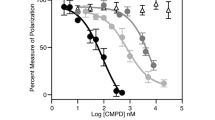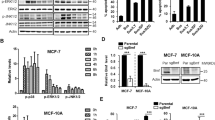Abstract
Changes in cell morphology are linked to many cellular events including cytokinesis, differentiation, migration and apoptosis. We recently showed that BNIP-Sα induced cell rounding that leads to apoptosis via its BNIP-2 and Cdc42GAP Homology (BCH) domain, but the underlying mechanism has not been determined. Here, we have identified a unique region (amino acid 133–177) of the BNIP-Sα BCH domain that targets RhoA, but not Cdc42 or Rac1 and only the dominant-negative form of RhoA could prevent the resultant cell rounding and apoptotic effect. The RhoA-binding region consists of two parts; one region (residues 133–147) that shows some homology to part of the RhoA switch I region and an adjacent sequence (residues 148–177) that resembles the REM class I RhoA-binding motif. The sequence 133–147 is also necessary for its heterophilic interaction with the BCH domain of the Rho GTPase-activating protein, p50RhoGAP/Cdc42GAP. These overlapping motifs allow tripartite competition such that overexpression of BNIP-Sα could reduce p50RhoGAP binding to RhoA and restore RhoA activation. Furthermore, BNIP-Sα mutants lacking the RhoA-binding motif completely failed to induce cell rounding and apoptosis. Therefore, via unique binding motifs within its BCH domain, BNIP-Sα could interact and activate RhoA while preventing its inhibition by p50RhoGAP. This concerted mechanism could allow effective propagation of the RhoA pathway for cell rounding and apoptosis.
This is a preview of subscription content, access via your institution
Access options
Subscribe to this journal
Receive 50 print issues and online access
$259.00 per year
only $5.18 per issue
Buy this article
- Purchase on Springer Link
- Instant access to full article PDF
Prices may be subject to local taxes which are calculated during checkout








Similar content being viewed by others
References
Aspenström P . (1999). Exp Cell Res 246: 20–25.
Aznar S, Lacal JC . (2001). Cancer Lett 165: 1–10.
Bando M, Miyake Y, Shiina M, Wachi M, Nagai K, Kataoka T . (2002). Biochem Biophys Res Commun 290: 268–274.
Bayless KJ, Davis GE . (2004). J Biol Chem 279: 11686–11695.
Bishop AL, Hall A . (2000). Biochem J 348: 241–255.
Bobak D, Moorman J, Guanzon A, Gilmer L, Hahn C . (1997). Oncogene 15: 2179–2189.
Boyd JM, Malstrom S, Subramanian T, Venkatesh LK, Schaeper U, Elangovan B et al. (1994). Cell 79: 341–351.
Chua BT, Volbracht C, Tan KO, Li R, Yu VC, Li P . (2003). Nat Cell Biol 5: 1083–1089.
Coleman ML, Olson MF . (2002). Cell Death Differ 9: 493–504.
Collard JG . (2004). Nature 428: 705–708.
Combet C, Blanchet C, Geourjon C, Deleage G . (2000). Trends Biochem Sci 25: 147–150.
Croft DR, Coleman ML, Li S, Robertson D, Sullivan T, Stewart CL et al. (2005). J Cell Biol 168: 245–255.
Dubreuil CI, Winton MJ, McKerracher L . (2003). J Cell Biol 162: 233–243.
Dvorsky R, Ahmadian MR . (2004). EMBO R 5: 1130–1136.
Fiorentini C, Fabbri A, Falzano L, Fattorossi A, Matarrese P, Rivabene R et al. (1998a). Infect Immun 66: 2660–2665.
Fiorentini C, Matarrese P, Straface E, Falzano L, Fabbri A, Donelli G et al. (1998b). Exp Cell Res 242: 341–350.
Flusberg DA, Numaguchi Y, Ingber DE . (2001). Mol Biol Cell 12: 3087–3094.
Frisch M, Screaton RA . (2001). Curr Opin Cell Biol 13: 555–562.
Gourlay CW, Ayscough KR . (2005). J Cell Sci 118: 2119–2132.
Hall A . (1998). Science 279: 509–514.
Huot J, Houle F, Rousseau S, Deschesnes RG, Shah GM, Landry J . (1998). J Cell Biol 143: 1361–1373.
Jenna S, Hussain NK, Danek EI, Triki I, Wasiak S, McPherson PS, et al. (2002). J Biol Chem 277: 6366–6373.
Kaufmann HS, Hengartner MO . (2001). Trends Cell Biol 11: 526–534.
Kim O, Yang J, Qiu Y . (2002). J Biol Chem 277: 30066–30071.
Kim S-J, Hwang S-G, Kim I-C, Chun J-S . (2003). J Biol Chem 278: 42448–42456.
Korichneva I, Hammerling U . (1999). J Cell Sci 112: 2521–2528.
Lim J, Wong ES, Ong SH, Yusoff P, Low BC, Guy GR . (2000). J Biol Chem 275: 32837–32845.
Lockshin RA, Zakeri Z . (2004). Oncogene 23: 2766–2773.
Low BC, Lim YP, Lim J, Wong ESM, Guy GR . (1999). J Biol Chem 274: 33123–33130.
Low BC, Seow KT, Guy GR . (2000a). J Biol Chem 275: 37742–37751.
Low BC, Seow KT, Guy GR . (2000b). J Biol Chem 275: 14415–14422.
Lua BL, Low BC . (2004). Mol Biol Cell 15: 2873–2883.
Melamed I, Gelfand EW . (1999). Cell Immunol 194: 136–142.
Mills JC, Stone NL, Pittman RN . (1999). J Cell Biol 146: 703–708.
Moon SY, Zheng Y . (2003). Trends Cell Biol 13: 14–23.
Posey SC, Bierer BE . (1999). J Biol Chem 274: 4259–4265.
Qin W, Hu J, Guo M, Xu J, Li J, Yao G et al. (2003). Biochem Biophys Res Commun 308: 379–385.
Reuveny M, Heller H, Bengal E . (2004). FEBS Lett 569: 129–134.
Ridley AJ . (2001). Trends Cell Biol 11: 471–477.
Saeki N, Tokuo N, Ikebe M . (2005). J Biol Chem 280: 10128–10134.
Sahai E, Marshall C . (2002). Nat Rev Cancer 2: 133–142.
Shang X, Zhou YT, Low BC . (2003). J Biol Chem 278: 45903–45914.
Song Y, Hoang BQ, Chang DD . (2002). Exp Cell Res 278: 45–52.
Spector DL, Goldman RD, Leinwand LA . (1998). Cells: A Laboratory Manual. Cold Spring Harbor Press: Cold Spring Harbor, NY.
Subauste MC, Herrath MV, Benard V, Chamberlain CE, Chuang T, Chu K et al. (2000). J Biol Chem 275: 9725–9733.
Suria H, Chau LA, Negrou E, Kelvin DJ, Madrenas J . (1999). Life Sci 65: 2697–2707.
Surks HK, Richards CT, Mendelsohn ME . (2003). J Biol Chem 278: 51484–51493.
Takahashi K, Sasaki T, Mammoto A, Takaishi K, Kameyama T, Tsukita S et al. (1997). J Biol Chem 272: 23371–23375.
Tosello-Trampont A-C, Nakada-Tsukui K, Ravichandran KS . (2003). J Biol Chem 278: 49911–49919.
Ueda H, Morishita R, Narumiya S, Kato K, Asano T . (2004). Exp Cell Res 298: 207–217.
Wang L, Yang L, Burns K, Kuan C-Y, Zheng Y . (2005a). Proc Natl Acad Sci USA 102: 13484–13489.
Wang L, Yang L, Filippi M-D, Williams DA, Zheng Y . (2005b). Blood, DOI 10.1182/blood-2005-05-2171.
Wennerberg K, Forget MA, Ellerbroek SM, Arthur WT, Burridge K, Settleman J et al. (2003). Curr Biol 13: 1106–1115.
White SR, Williams P, Wojcik KR, Sun S, Hiemstra PS, Rabe KF et al. (2001). Am J Respir Cell Mol Biol 24: 282–294.
Yamashita T, Tohyama M . (2003). Nat Neurosci 6: 461–467.
Zhou X, Thorgeirsson SS, Popescu NC . (2004). Oncogene 23: 1308–1313.
Zhou YT, Guy GR, Low BC . (2005). Exp Cell Res 303: 263–274.
Zhou YT, Soh UJ, Shang X, Guy GR, Low BC . (2002). J Biol Chem 277: 7483–7492.
Acknowledgements
Yi Ting Zhou is a Singapore Millennium Foundation Scholar. This work was supported by grants from the Academic Research Fund, The National University of Singapore and the Biomedical Research Council of Singapore. We thank Dr Alan Hall for the generous gifts of the original cDNA for Rho and p50RhoGAP.
Author information
Authors and Affiliations
Corresponding author
Rights and permissions
About this article
Cite this article
Zhou, Y., Guy, G. & Low, B. BNIP-Sα induces cell rounding and apoptosis by displacing p50RhoGAP and facilitating RhoA activation via its unique motifs in the BNIP-2 and Cdc42GAP homology domain. Oncogene 25, 2393–2408 (2006). https://doi.org/10.1038/sj.onc.1209274
Received:
Revised:
Accepted:
Published:
Issue Date:
DOI: https://doi.org/10.1038/sj.onc.1209274
Keywords
This article is cited by
-
A phase II study of medroxyprogesterone acetate in patients with hormone receptor negative metastatic breast cancer: translational breast cancer research consortium trial 007
Breast Cancer Research and Treatment (2014)
-
c-Jun NH2-terminal kinase activation is essential for up-regulation of LC3 during ceramide-induced autophagy in human nasopharyngeal carcinoma cells
Journal of Translational Medicine (2011)
-
Biotransformation and pharmacokinetics of the novel anticancer drug, SYUIQ-5, in the rat
Investigational New Drugs (2008)



